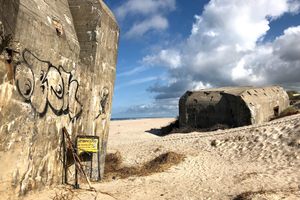About
Two hundred years ago, sand drift formed a flat, marshy peninsula on the Danish west coast, and it wasn't long before the region's birds discovered this uninhabited sanctuary. The hunters soon followed, along with their settlement of ramshackle cabins built from whatever materials were readily available: driftwood, recycled roofing, even pieces of cigar boxes.
The cabins were very basic, consisting of a single room, no running water or electricity. They were constantly deteriorating and under repair in the harsh western winds and North Sea weather, but they provided a much-needed place of shelter for hunters and fishermen. However conservationists recognised the area's value to the migratory birds like Godwits and Ruffs who used the peninsula to roost, and when part of the peninsula was designated a conservation area in 1928, the cabins and the human activity that came with them were an issue.
The Second World War (ironically) provided some peace and quiet for the birds because the occupying Germans cut off human access to the area. After the war, the hunters came back to reclaim and rebuild again, and the 400-strong community became engaged in another battle. In 1977 a conservation law was passed that demanded the cabins to be removed by 1995. The community mounted their own legal conservation case and presented a claim that the simple cabins were of local, historical and cultural value.
The dispute continued for decades, and still both the birds and the hunters returned year after year. Finally, in 2002, the now 327 cabins were granted conservation status, but with strict rules, including forbidding any new cabins from being built. No electricity mains, running water, satellite dishes, drainage or flagpoles are allowed (though violations have been spotted).
The result is an eerie, quiet feeling on the peninsula. Several houses are unused and unoccupied at any given time. You will not meet more than a handful of people here, most of them busy repairing their huts, largely ignoring visitors.
Related Tags
Know Before You Go
Continue along Tippervej, just after you pass a few brick houses, turn left on the gravel road.
If you want to continue to the nature reserve, beware that stopping isn't allowed before the lookout on the coast.
Community Contributors
Added By
Published
January 17, 2017




















































